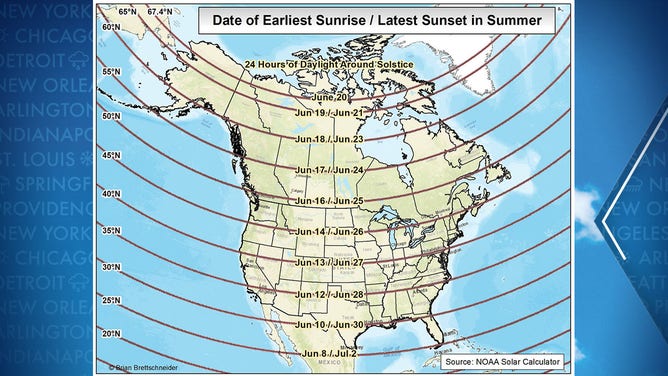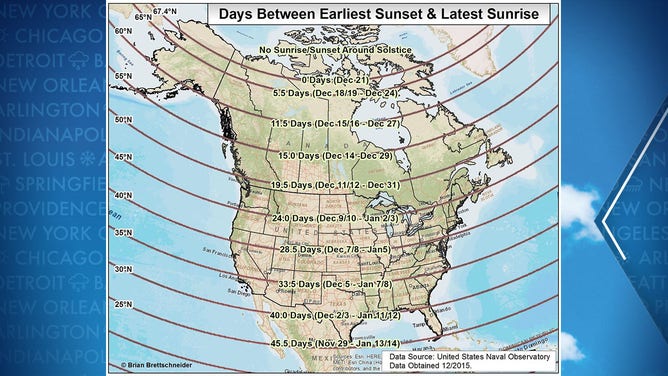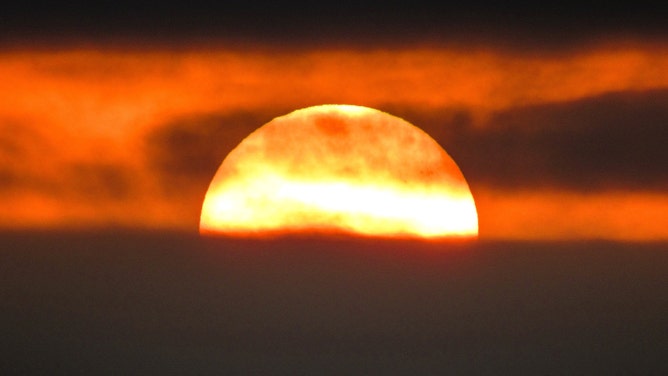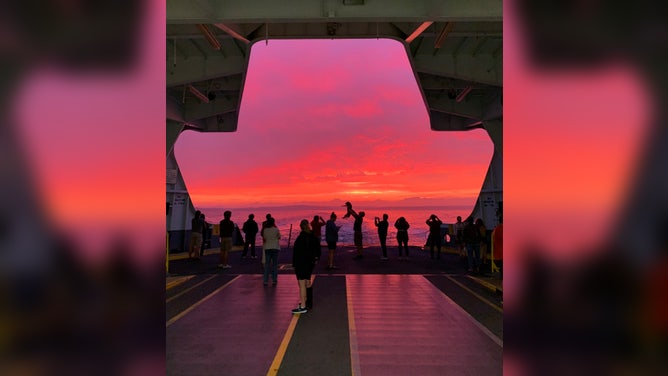Why are earliest sunrises a week or more before summer solstice?
Most people know the summer and winter solstices are the longest and shortest days of the year, respectively. What you may not know is that the earliest and latest sunrises and sunsets don’t coincide with the solstices.
Smoke from Canadian wildfires makes for hazy sunset in Ohio
Smoke from Canadian wildfires makes for a hazy sunset in Toledo, Ohio, on May 16, 2023 (Credit: @TerryEckmanWx via Storyful).
It seems so simple from school astronomy: The first day of summer is the longest day of the year, and the first day of winter is the shortest. And while that is true in the strict amount of daylight observed, reality doesn't always seem to follow logic.
For example, much of the U.S. will see its earliest sunrises a week or more before the summer solstice on June 21. The earliest sunrise of the year in Key West, Florida, is around June 8. Additionally, the sun rises more than 30 minutes earlier in Caribou, Maine, in mid-June than in Seattle, despite Seattle being farther north where summer days are supposed to be slightly longer.
WHY SUMMER SHOULD ACTUALLY BEGIN ON JUNE 1
It's all because we as humans prefer to work with nice, round numbers, while the planetary alignments that bring us our seasons do not.
Let's start with the Key West puzzle, which is just a sliver of an example of what might be unexpected about sunrises and sunsets across the nation. For most of America, the earliest sunrises of the year occur before the summer solstice, while the latest sunsets don’t happen until after the solstice.

Date of earliest sunrise and latest sunset in summer.
(Dr. Brian Brettschneider)
Near the winter solstice, this difference is even more noticeable. Depending on where you are in the country, the earliest sunsets might occur closer to Thanksgiving than Christmas.
However, the latest winter sunrises (without factoring in daylight saving time) won't happen until after the new year.
WATCH A YOSEMITE WATERFALL ROAR AS WINTER'S HISTORIC SNOW MELTS
The primary reason the earliest and latest sunrises and sunsets don’t coincide with the solstices is best explained by the equation of time.

Date of earliest sunset and latest sunrise in winter.
(Dr. Brian Brettschneider)
For starters, the Earth is not perfectly round, and neither is its orbit around the sun. The Earth is closer to the sun in January (perihelion) than in July (aphelion) due to its elliptically shaped orbit. This, combined with the Earth slightly changing the speed at which it revolves around the sun at different points throughout the year, is the simplest explanation for why the solstices generally don’t have the earliest and latest sunrises and sunsets.
From there, the explanation gets quite complex. If you want to dive into the astronomical details, check out this well-written explanation by Harvard-graduate Dr. Larry Denenberg.
But these minor variances in Earth's orbit result in the displacement of the earliest sunrises and latest sunsets in the weeks surrounding June’s summer solstice. So while mornings might be getting noticeably shorter by the Fourth of July, the evening light continues to hang on later than it does all year.
SCORCHING SUMMER PREDICTED ACROSS U.S. WITH NO AREAS FORECAST TO BE COOLER THAN AVERAGE
Conversely, you’re probably already enjoying longer evenings on Christmas Day and New Year’s Eve than earlier in December. Still, it might take until early to mid-January to start slowly gaining morning daylight. The earliest sunset occurs more than a month before the latest winter sunrise in parts of the southern U.S.
(For a more complex and detailed description, we encourage you to read Denenberg’s explanation for yourself or research the equation of time.)
@foxweather The sun is setting in four hours. NYC’s earliest sunset of the year is December 7, 2021. #nycsunset #sunset #winter #nyc ♬ original sound - FOX Weather
Humans have a hand in this as well
So that explains why the peak sunrise and sunset times are offset from the solstices, but how does Caribou, which sees the sunrise around 4:37 a.m. in June, get its first crack of dawn some 34 minutes before Seattle, where the sun isn't up until 5:11 a.m. despite being farther north on the map where summer days are longer?

The sunrise is photographed in Seattle on Friday, May 19, 2023.
(NWS Seattle / NOAA)
Blame the way we set up time zones and how it leaves some towns misaligned with the sun. There are 24 hours in a day and 360 degrees of longitude around our spherical planet, so each time zone is set at roughly 15-degree longitude intervals as you circle the globe.
But "roughly" is the key to this mystery.
To have our clocks best match the solar positions, you'd want to be as close to those 15-degree longitude lines as possible. For the Eastern time zone, cities that are right along 75 degrees west longitude are best aligned to have the sun be at "solar noon" – as in its highest point of the day – around the same time our clocks actually say noon. As you move away from that longitude but keep the same time zone, you'll become offset from solar noon.
Caribou is quite offset, sitting at 68 degrees west – just a few miles from Canadian towns in the Atlantic time zone that would be an hour ahead. So those living just a short drive away to the east in New Brunswick, Canada, don't see the sun crack the horizon until around 5:37 a.m. If we wanted Caribou's clocks to be more accurate to the sun's position, they should be in a time zone that is about 30 minutes ahead of Eastern Standard Time. Then, daylight would come at 5:07 a.m.
Meanwhile, Seattle is at 122 degrees west, nearly centered in the Pacific time zone. Clocks there are just about on perfect time for the solar position – solar noon in June is just 7 minutes off from matching actual noon. (Though technically, it's an hour and 7 minutes off because of the artificial hour-ahead adjustment for daylight saving time.) Seattle's sunrise in mid-June: 5:11 a.m., only 4 minutes later than Caribou's would be if its time zone was offset by 30 minutes to more closely align it with the sun.
ACTIVE FIRE SEASON FORECAST FOR PACIFIC NORTHWEST, MIDWEST WHILE SOUTHWEST GETS A BREAK
So are Maine's days longer, then?
No. East and west timekeeping quirks aside, being farther north in the Northern Hemisphere while approaching the summer solstice means your days are indeed longer than those to your south. Seattle makes up the difference in the late evening. Sunset on June 15 in Caribou is at 8:28 p.m., but it’s not until 40 minutes later in Seattle at 9:08 p.m.
That means despite the later start, Seattle does have about 6 minutes more daylight than Caribou in mid-June, and all is right with the sunlit planetary world.

The sunset, rain and smoke from wildfires in the Pacific Northwest created a colorful sunset in Seattle on Sept. 11, 2022.
(Joe Boomgard-Zagrodnik / Twitter)
(For more maps and charts that show the differences between sunrise and sunset times across the continent, check out Dr. Brian Brettschneider's blog.)
